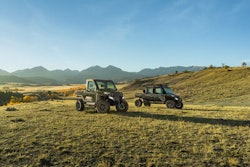It was a matter of the right timing, says Volvo. Europe’s anti-vibration regulations are now reality, and over here, escalating prices have underlined the need for even more productivity. Time to roll out a project the company estimates it has been working on for close to 20 years: a full-suspension artic.
The full-suspension units – the 37-ton A35E FS and 40-ton A40E FS, which Volvo started offering in September – depend on sensors to monitor and regulate the open-flow hydraulics between six hydraulic cylinders, two placed before the articulation joint and four in the rear. “The machine is always putting hydraulic pressure in the right place at the right time,” says Blaine Pressley with Volvo Construction Equipment’s hauler/loader business line. “In going around a curve, for example, when the weight shifts to one side, the hydraulics automatically compensate for the weight shift and provide a more stable load-carrying situation.”
In addition to the four hydraulic cylinders in the rear of the machine, there are two high-pressure accumulators for fully loaded conditions and two low-pressure accumulators for empty return runs that give the artic the ability to absorb impacts during operation.
Volvo says the full suspension will really shine on jobs with long haul cycles with rough, hard roads – and with an estimated $50,000 premium the payback period can be one year or less. “Regardless of the haul road conditions,” Pressley says, “operator comfort and productivity gains will always be enhanced.”
According to the company, full-suspension offers:
- Higher productivity and better comfort – Volvo says in U.S. tests conducted at select customer sites, operators using the full-suspension trucks saw up to a 32 percent increase in productivity on the roughest terrains. (See charts on page 56.)
- Better off-road performance and higher speeds when cornering – The hydraulic system provides a smooth ride, plus an anti-roll function since cylinders are filled with hydraulic oil as needed to keep the body and frame in line with the axles.
- Less road maintenance – Since the machines can manage rougher terrains, there’s less need to be fussy about haul road smoothness.
A true demo of the full suspension machine requires a.) a site with areas of medium to severe rough terrain, and b.) the ability to compare it with a non-full suspension machine immediately afterwards. Once operators get comfortable with the machine’s feel, Volvo says, the productivity gains begin. “Our test operators told us they didn’t want to go back to a machine without full suspension,” Pressley says. “They said they were nowhere near as tired at the end of the day as they would be with a standard artic.”
Maintenance also remains uncomplicated. Just check the system – including cylinder bushings and accumulator charges – every 2,000 hours and replace/recharge components as necessary.
And it’s operator friendly: flip a switch at the end of the day to recirculate the system hydraulic oil back to tank – and through the oil filter. Flip the same switch the next morning and you’re back in full suspension mode.
How it works
In the graphic below, the red round dots show the open flow between all cylinders and the main hydraulic system. The green line represents the open flow between the mid and rear axle cylinders. At the rear of the machine, the dark red dashes show the cross flow between left and right rear cylinders and the blue dashes represent the cross flow between the front-right/rear-left cylinders and the front-left/rear-right cylinders.
U.S. customer tests
Volvo began testing the full suspension option at four different customer land clearing jobsites in late 2007. The charts below show the two sites with most pronounced rough terrain conditions – on the “extremely rough and dry” site Volvo also installed some additional obstacles for the test. The savings potential was calculated with a $1 per yard bid price and based on a 2,000-hour year. During testing, Volvo saw the most productivity gains during the empty return cycle, although the loaded haul cycle also saw gains. In each test, the same operator drove both the full-suspension and the non-full-suspension test machines.
Cost breakdown
Volvo says customers using a full-suspension artic may see a payback for its $50,000 premium in one year or less.
Here’s how they calculate this return on a 1.2-mile round trip cycle over rough terrain.
Average standard artic total cycle time (seconds): 447.60
Average A40E full suspension total cycle time (seconds): -370.00
Average full suspension cycle time advantage (seconds): 77.60
Average A40E full suspension cubic yards (per 50 min. hour): 253.50
Average standard artic total cubic yards (per 50 min. hour): -209.60
Average full suspension productivity advantage (cubic yards): 43.90
Full suspension productivity advantage(43.90 divided by 209.60): 20.94%
One-year payback calculation, based on
$1 per cubic yard bid price and 2,000 hours of use: $43.90 x 2,000 hours = $87,800









